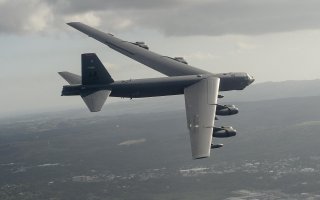You Can't Stop the B-52 Bomber in a War. Period.
Capable of delivering huge payloads at vast distances, the B-52 bomber quickly became a U.S. Air Force staple in the Vietnam War. And it's still going strong.
Here's What You Need to Remember: The B-52 strategic bomber has its roots in a postwar procurement search for a heavy strategic bomber.
One of America’s most iconic bombers, the B-52 Stratofortress has managed to outlive its Cold War roots and is set to see service through the mid-twenty-first century.
The B-52 strategic bomber has its roots in a postwar procurement search for a heavy strategic bomber. Boeing, along with several competing companies, submitted dueling proposals. Boeing’s candidate, a colossal straight-wing aircraft called the Model 462, went on to win the tender in 1946. The process stalled amid a prolonged series of negotiations between Boeing and the Air Force, with the latter expressing concerns over the proposed bomber’s weight, speed, and bulky design. In the years that followed, Boeing churned out additional concept models that were lighter and faster—the initial design was eventually abandoned in favor of swept wings. It was only after six years, in 1952, that prototypes began to enter pre-production. By then, the strategic bomber was a thoroughly different plane from the early design concept introduced by Boeing in 1946.
Powered by Pratt & Whitney J57-P-1W turbojets that were later replaced by the markedly more powerful P&W TF33-P-3 turbofans, the B-52 supports a payload of up to 31,500 kilograms and boasts an operational range of just over fourteen thousand kilometers without aerial refueling. The B-52 isn’t particularly maneuverable or fast at a top speed of just over one thousand kilometers per hour, nor does it need to be; its primary purpose was to fly deterrence missions against the Soviet Union throughout the Cold War.
In keeping with its raison dêtre, B-52 is prodigiously armed. Beginning with its “H” revision, the B-52 bomber’s nuclear weapons capability was headlined by twelve AGM-129 advanced cruise missiles and twenty AGM-86A air-launched cruise missiles? The AGM-86A was theoretically able to overwhelm Soviet missile defenses with saturation strikes launched outside of Soviet airspace. The B-52 bomber likewise supports an exhaustive list of weapons for a wide range of conventional missions: among them, AGM-84 Harpoon missiles, joint direct-attack munitions (JDAM), AGM-142 Raptor missiles, and AGM-86C conventional air-launched cruise missiles (CALCM).
Capable of delivering huge payloads at vast distances, the B-52 bomber quickly became a U.S. Air Force staple in the Vietnam War. The strategic bombers flew hundreds of combat sorties and dropped over fifteen tons of bombs on North Vietnamese targets during Operation Linebacker II. More recently, the B-52 bomber distinguished itself during Operation Desert Storm: “B-52s struck wide-area troop concentrations, fixed installations and bunkers, and decimated the morale of Iraq’s Republican Guard,” read an Air Force statement.
The B-52 bomber’s greatest long-term strength has proven to be its flexibility, and nowhere is this more apparent than its remarkable ability to assimilate new weapons platforms. There are plans to upgrade B-52 bombers with AGM-183A hypersonic missiles as part of the U.S. military’s response to Russia’s recent strides in test-launching hypersonic cruise missiles.
In addition to new weapons, the Air Force’s fleet of seventy-six B-52s is slated to receive a raft of avionics and targeting updates to keep them relevant into the coming decades. B-52’s are currently being retrofitted with new data links and upgraded communications suites, as well as additional countermeasures and navigation features.
Combining a remarkably resilient airframe with a modular design approach, the B-52 bomber will be among America’s longest-serving aircraft when it eventually retires in the 2050s.
Mark Episkopos is a national security reporter for the National Interest.
Image: Reuters

